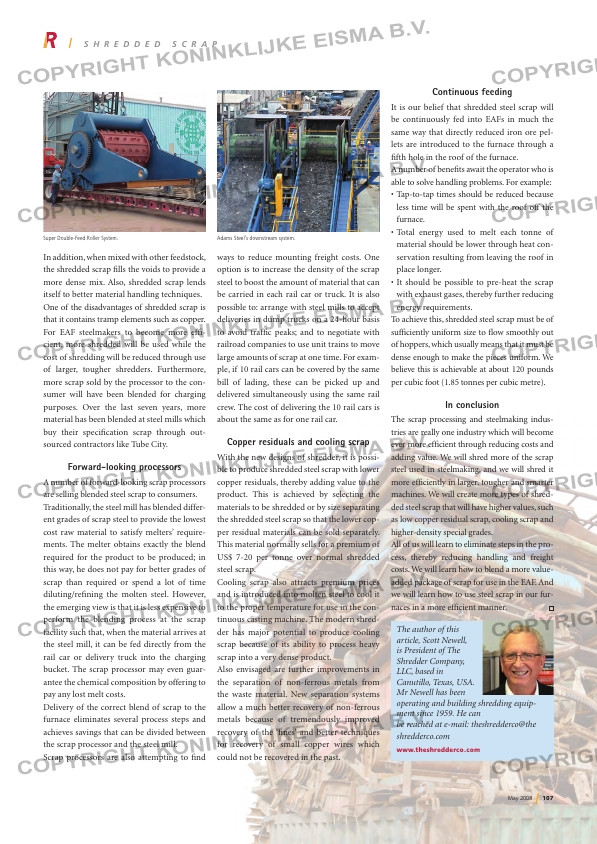Page 107 from: May 2008

May 2008 107
S h r e d d e d S c r a p
In addition, when mixed with other feedstock,
the shredded scrap fi lls the voids to provide a
more dense mix. Also, shredded scrap lends
itself to better material handling techniques.
One of the disadvantages of shredded scrap is
that it contains tramp elements such as copper.
For EAF steelmakers to become more effi –
cient, more shredded will be used while the
cost of shredding will be reduced through use
of larger, tougher shredders. Furthermore,
more scrap sold by the processor to the con-
sumer will have been blended for charging
purposes. Over the last seven years, more
material has been blended at steel mills which
buy their specifi cation scrap through out-
sourced contractors like Tube City.
Forward-looking processors
A number of forward-looking scrap processors
are selling blended steel scrap to consumers.
Traditionally, the steel mill has blended differ-
ent grades of scrap steel to provide the lowest
cost raw material to satisfy melters’ require-
ments. The melter obtains exactly the blend
required for the product to be produced; in
this way, he does not pay for better grades of
scrap than required or spend a lot of time
diluting/refi ning the molten steel. However,
the emerging view is that it is less expensive to
perform the blending process at the scrap
facility such that, when the material arrives at
the steel mill, it can be fed directly from the
rail car or delivery truck into the charging
bucket. The scrap processor may even guar-
antee the chemical composition by offering to
pay any lost melt costs.
Delivery of the correct blend of scrap to the
furnace eliminates several process steps and
achieves savings that can be divided between
the scrap processor and the steel mill.
Scrap processors are also attempting to fi nd
ways to reduce mounting freight costs. One
option is to increase the density of the scrap
steel to boost the amount of material that can
be carried in each rail car or truck. It is also
possible to: arrange with steel mills to accept
deliveries in dump trucks on a 24-hour basis
to avoid traffi c peaks; and to negotiate with
railroad companies to use unit trains to move
large amounts of scrap at one time. For exam-
ple, if 10 rail cars can be covered by the same
bill of lading, these can be picked up and
delivered simultaneously using the same rail
crew. The cost of delivering the 10 rail cars is
about the same as for one rail car.
Copper residuals and cooling scrap
With the new designs of shredder, it is possi-
ble to produce shredded steel scrap with lower
copper residuals, thereby adding value to the
product. This is achieved by selecting the
materials to be shredded or by size separating
the shredded steel scrap so that the lower cop-
per residual materials can be sold separately.
This material normally sells for a premium of
US$ 7-20 per tonne over normal shredded
steel scrap.
Cooling scrap also attracts premium prices
and is introduced into molten steel to cool it
to the proper temperature for use in the con-
tinuous casting machine. The modern shred-
der has major potential to produce cooling
scrap because of its ability to process heavy
scrap into a very dense product.
Also envisaged are further improvements in
the separation of non-ferrous metals from
the waste material. New separation systems
allow a much better recovery of non-ferrous
metals because of tremendously improved
recovery of the ‘fi nes’ and better techniques
for recovery of small copper wires which
could not be recovered in the past.
The author of this
article, Scott Newell,
is President of The
Shredder Company,
LLC, based in
Canutillo, Texas, USA.
Mr Newell has been
operating and building shredding equip-
ment since 1959. He can
be reached at e-mail: theshredderco@the
shredderco.com
www.theshredderco.com
Continuous feeding
It is our belief that shredded steel scrap will
be continuously fed into EAFs in much the
same way that directly reduced iron ore pel-
lets are introduced to the furnace through a
fi fth hole in the roof of the furnace.
A number of benefi ts await the operator who is
able to solve handling problems. For example:
• Tap-to-tap times should be reduced because
less time will be spent with the roof off the
furnace.
• Total energy used to melt each tonne of
material should be lower through heat con-
servation resulting from leaving the roof in
place longer.
• It should be possible to pre-heat the scrap
with exhaust gases, thereby further reducing
energy requirements.
To achieve this, shredded steel scrap must be of
suffi ciently uniform size to fl ow smoothly out
of hoppers, which usually means that it must be
dense enough to make the pieces uniform. We
believe this is achievable at about 120 pounds
per cubic foot (1.85 tonnes per cubic metre).
In conclusion
The scrap processing and steelmaking indus-
tries are really one industry which will become
ever more effi cient through reducing costs and
adding value. We will shred more of the scrap
steel used in steelmaking, and we will shred it
more effi ciently in larger, tougher and smarter
machines. We will create more types of shred-
ded steel scrap that will have higher values, such
as low copper residual scrap, cooling scrap and
higher-density special grades.
All of us will learn to eliminate steps in the pro-
cess, thereby reducing handling and freight
costs. We will learn how to blend a more value-
added package of scrap for use in the EAF. And
we will learn how to use steel scrap in our fur-
naces in a more effi cient manner.
Adams Steel’s downstream system.Super Double-Feed Roller System.
RI_061_Shredded Scrap.indd 5 14-05-2008 14:04:45



